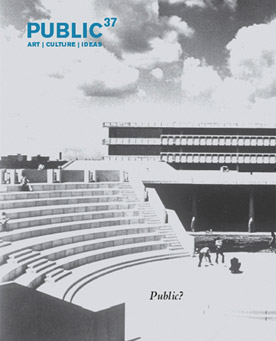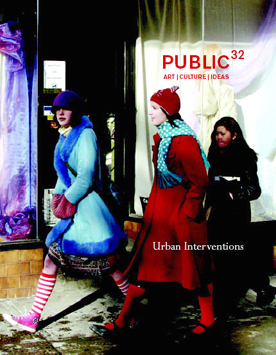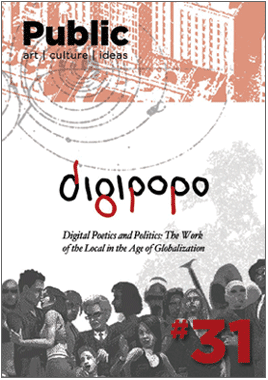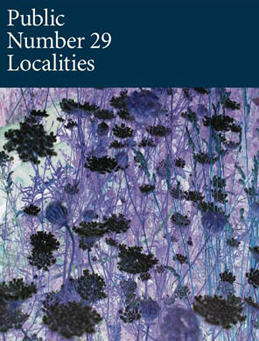Public is a unique interdisciplinary journal that explores contemporary cultural issues. Bridging scholarly and critical studies with artistic practices, the journal provides a forum in which international artists, critics and theorists exchange ideas on topics previously segregated by ideological boundaries.
Public is published by the Public Access Collective, which was founded out of a shared need to be part of a community-based organization that is open to innovative ways for curating the visual arts in the public domain. Working to organize its projects, the group functions mainly in curatorial and research capacities.
The current members of the Public Access Collective are Ken Allan, Lang Baker, Chloë Brushwood-Rose, Nancy Campbell, Christine Davis, Caitlin Fisher, Susan Lord, Janine Marchessault, Dorit Namaan, Deborah Root, and Kathryn Walter.
Additional information:
Public 37, "Public?" (2008), co-edited by Aleksandra Kaminska, Janine Marchessault and Jason Rovito
Articles for download from this issue: Aleksandra Kaminska, Janine Marchessault, and Jason Rovito, "Introduction"
|
Public 32, "Urban Interventions" (2005), co-edited by Saara Liinamaa, Janine Marchessault and Karyn Sandlos
Articles for download from this issue: Saara Liinamaa, "Of Treasures and Trash: BookCrossing, Mark Dion’s Tate Thames Dig and the (lost) objects of urban intervention"
|
Public 31, “Digital Poetics and Politics” (2005), co-edited by Glenn Gear, Susan Lord, Dorit Naaman, Matt Soar and Miriam Verburg
The combined DVD/Website that comprise this special issue of Public provides responses to such issues and conditions, which are inextricable from global networks, flows of capital, and migration. Among contributions from international media artists and academics, Public 31 features the outline of a collaborative project by Professors Susan Lord (Queen’s University) and Janine Marchessault (Director of the Visible City Project, York University). Entitled "Translocal Connectivities and Citizenship Practices in the New Media Arts," this program of research draws out a network of relations between five cities: Havana, Merida, Helsinki, Vienna, and Toronto. The study undertakes a detailed analysis of contemporary artists’ groups, collective projects and exhibitions that use new media technologies (internet, digital media, cell phones) to increase trans-local connections and civic participation, and to innovate artistic forms out of intercultural collaboration and circulation. The Visible City Project + Archive will serve to preserve the research materials and make them available to new media researchers.
|
Public 29, “Localities” (Summer 2004), co-edited by Saara Liinamaa, Janine Marchessault and Christine Shaw
This issue of Public approaches the concept of locality in a dialectical fashion—seeing in it new possibilities for trans-localism, diverse coalitions, and critical engagements as well as new reactionary articulations of market fundamentalism, and commodified difference. Articles for download from this issue: Saara Liinamaa, "Awaiting the Disaster: Olafur Eliasson’s The Weather Project"
|





